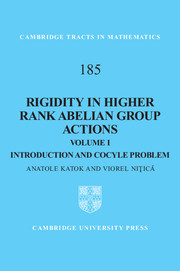Book contents
3 - Preparatory results from analysis
from Part I - Preliminaries from dynamics and analysis
Published online by Cambridge University Press: 05 July 2011
Summary
Introduction
A classical and fairly elementary result from Fourier analysis asserts that a continuous function f : ℝ2 → ℝ is actually C∞ assuming only that the partial derivatives ∂nf/∂xn and ∂nf/∂yn exist for all positive integers n. To prove this result, one can use, for example, techniques from Chapter 1 of the classical book of Stein and Weiss [167]. No mixed partial derivatives are necessary here. For a smooth manifold M, this result can be easily extended to functions f : M → ℝ that are smooth along pairs of transverse smooth foliations on M, or even to functions that are smooth along a web of smooth foliations with tangent distributions spanning the tangent bundle TM. Moreover, general results can be obtained for functions that are smooth along pairs of transverse Hölder foliations with smooth leaves. The later type of results are often used in rigidity in order to show higher regularity for solutions of cohomological equations over hyperbolic and partially hyperbolic systems. In this setup, the corresponding transverse foliations are the stable and unstable foliations associated to the system. A more complete discussion of this relationship can be found in Chapters 4 and 5.
The main goal of this chapter is to present, as far as possible, complete proofs and references for several results along this theme that appear in the literature. We start with the well-known result of Journé [58], about Cn,α regularity of a continuous function that is Cn,α along two transverse continuous foliations with Cn,α leaves.
- Type
- Chapter
- Information
- Rigidity in Higher Rank Abelian Group Actions , pp. 100 - 130Publisher: Cambridge University PressPrint publication year: 2011



